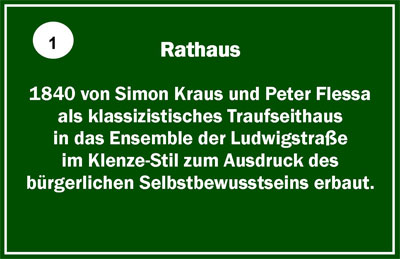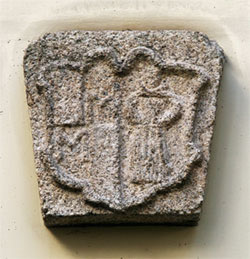
Town Hall

Building Number 1 in the printed brochure
"Historic Buildings in Münchberg".
The sign is on the left, next to the entry door.
Around 1224 "Munchiberc" was mentioned for the first documented time and in 1298 “civitas” designated it as a city. On July 13, 1364 Münchberg was awarded the privileges and rights of the free imperial city of Nürnberg by the Lords of Sparneck.
 Since 1488 they have had a town hall, which was destroyed several times by fire and stood somewhat further south. After the unfortunate fire of 1631 two houses were newly erected further north on the present site. In 1729 and 1837 the town fell victim to fire yet again. With the new construction in 1840 the southern bordering house was included, so that the town hall now became somewhat larger. In 1953 the terraces came into being on the street side, in order to make a ground entry level entry possible. In 1956 they expanded the building into the yard in the back with office spaces and garages. In 1981 a complete renovation succeeded under the restrictions of monument protection after which the roof from 1840 as lowered to 65 centimeters and the load capacity was threatened due to rot and fungus. With the renovation the little tower, which had served as an observation post for air attacks during World War II, was also removed. Before the First World War two clocks had hung in the tower, which were then, however, melted for munitions. The large addition on the west side could be entered from the city treasury and the building offices. In the interior of the building a granite staircase has been used since 1883. In the hall there are cross vaults and the walls are decorated with textile works from the local textile training institutions. The sitting room has three stained glass windows and an oil painting, which portrays the awarding of the city laws, hangs in the staircase.
Since 1488 they have had a town hall, which was destroyed several times by fire and stood somewhat further south. After the unfortunate fire of 1631 two houses were newly erected further north on the present site. In 1729 and 1837 the town fell victim to fire yet again. With the new construction in 1840 the southern bordering house was included, so that the town hall now became somewhat larger. In 1953 the terraces came into being on the street side, in order to make a ground entry level entry possible. In 1956 they expanded the building into the yard in the back with office spaces and garages. In 1981 a complete renovation succeeded under the restrictions of monument protection after which the roof from 1840 as lowered to 65 centimeters and the load capacity was threatened due to rot and fungus. With the renovation the little tower, which had served as an observation post for air attacks during World War II, was also removed. Before the First World War two clocks had hung in the tower, which were then, however, melted for munitions. The large addition on the west side could be entered from the city treasury and the building offices. In the interior of the building a granite staircase has been used since 1883. In the hall there are cross vaults and the walls are decorated with textile works from the local textile training institutions. The sitting room has three stained glass windows and an oil painting, which portrays the awarding of the city laws, hangs in the staircase.
From 1867 to 1967 the police, and until 1921 the bank, were housed in the building that was built in Klenze style. To the right of the entry there are still iron rods on which the measurements for feet and elbows can be taken. In the attic floor one finds the storage for the margrave’s grain. Under the free steps to the left of the entry are the little cells used as punishment for minor offenses, similar to how delinquents were publicly displayed on the pillory.
Video: Aerial view – Town Hall and Ludwigstraße
Copywriters, authors, photographers, rights holders or sources:
Rainer Fritsch, Sandy Schroeder, Jürgen Krauß, city archives